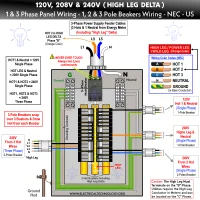jar546
CBO
All three-phase service meter cans for 120/240 Delta 3-Phase w/208v High-Leg require the high-leg to be on the C phase for the meter to work correctly. Electricians must know that they must switch the C-phase wire from the load side of the meter to the B phase of the service disconnect and all panelboards, switchboards, switchgear, etc., to comply with 408.3(E) of the NEC.
Do the POCOs in your area have the same setup for their meter cans? In all the counties and regions I worked in inside two different states, it's the same.
Image below courtesy of www.electricaltechnology.org

Do the POCOs in your area have the same setup for their meter cans? In all the counties and regions I worked in inside two different states, it's the same.
Image below courtesy of www.electricaltechnology.org

